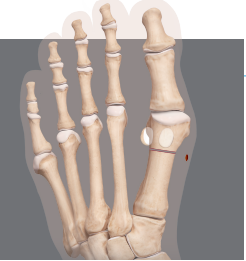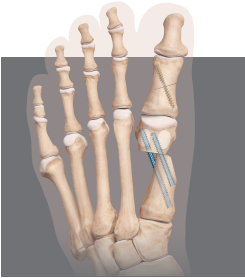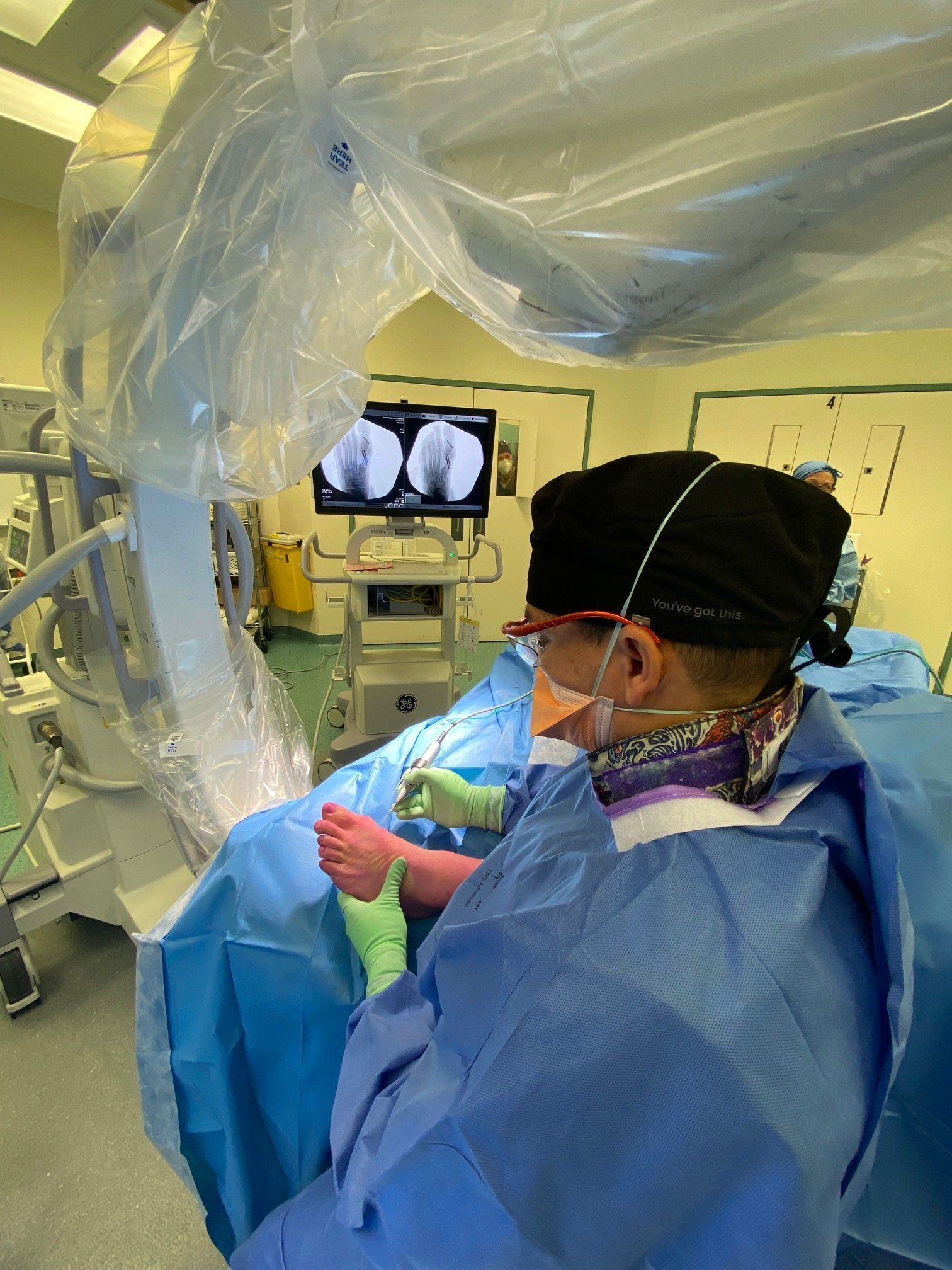Foot & Ankle
Bunion Surgery
A bunion is a painful bony prominence that forms at the base of the big toe, causing the toe to deviate toward the smaller toes. This condition, known as Hallux Valgus, often leads to pain, swelling, and stiffness in the foot. As the bunion progresses, it can limit footwear choices and make it difficult to perform daily activities. When non-surgical treatments such as changes in footwear, pain medications, or physical therapy do not alleviate pain, bunion surgery may be recommended. The goal of surgery is to restore normal foot alignment, reduce pain, and allow the patient to wear comfortable shoes again.
What is Bunion Surgery?
Bunion surgery involves the realignment of the bones around the big toe joint to reduce the deformity and restore proper function. Osteotomy, a common surgical technique for bunion correction, involves cutting and realigning the bones. Dr. Ryan du Sart performs minimally invasive bunion surgery, also known as keyhole surgery, to reduce scarring, pain, and recovery time compared to traditional surgery.
When is Bunion Surgery Recommended?
Bunion surgery may be recommended when:
- Non-surgical treatments (e.g., medications, physical therapy, or shoe modifications) have been ineffective.
- The pain significantly interferes with daily activities or limits mobility.
- There is severe deformity in the big toe joint (metatarsophalangeal joint).
- There is difficulty finding
comfortable footwear due to the bunion.
Bunion Surgery Procedure
Dr. du Sart performs the procedure using minimally invasive techniques to ensure a faster recovery and less discomfort. The surgery involves several key steps:
- Small Incisions: Tiny incisions are made around the affected area to access the joint.
- Bone Cuts: Under X-ray guidance, Dr. du Sart uses specialised tools to make corrective cuts to the 1st metatarsal and proximal phalanx bones.
- Realignment: The bones are shifted to correct the alignment of the big toe joint (MTP joint). The correction is held in place using zero-profile screws to minimize discomfort from the hardware.
- Restoration of Foot Function: These adjustments improve both the cosmetic appearance and mechanical function of the foot, potentially improving the range of motion at the big toe joint.
Benefits of Minimally Invasive Bunion Surgery
- Less Pain: The small incisions used during the surgery result in less post-operative pain compared to traditional methods.
- Reduced Scarring: Smaller incisions mean less visible scarring and a quicker recovery time.
- Faster Recovery: Most patients experience a faster healing process, allowing them to return to normal activities sooner.
- Improved Foot Function: The surgery restores proper alignment and reduces discomfort, enabling patients to wear comfortable shoes and return to an active lifestyle.




Post-Surgery Recovery and Rehabilitation
Pain Management
After your surgery, the pain will be managed through:
- Pain Relief Medications: Paracetamol and anti-inflammatory drugs are commonly prescribed to manage post-operative pain.
- Ice Therapy: Regular application of ice for 20 minutes, 3-4 times per day, can help reduce swelling and manage pain in the affected area.
Mobility
After your surgery, you will be able to walk with a surgical shoe to support your foot. Depending on your healing, you may use crutches for added support. You will continue to wear the surgical shoe for approximately three weeks, then progress to a stiff-soled sneaker to maintain proper alignment and reduce pressure on the toe.
Rehabilitation exercises will be prescribed to:
- Improve range of motion in the affected toe joint.
- Strengthen surrounding foot muscles.
- Prevent stiffness and improve function in the long term.
Return to Sports
For most patients, returning to high-impact or running sports may take between 3 to 6 months, depending on the type of surgery performed and the level of activity. 3 to 6 months, depending on the type of surgery performed and the level of activity.a
Driving Post-Surgery
For patients who have had left foot surgery and drive an automatic car, returning to driving may take as little as 2 weeks. However, if your right foot was operated on, the typical recovery time before driving is 6 weeks. Full mobility and strength are required to ensure it is safe to drive again.
Why Choose Dr. Ryan du Sart for Bunion Surgery?
Dr. Ryan du Sart is a highly experienced orthopaedic surgeon specialising in foot and ankle surgery. With his advanced minimally invasive techniques, Dr. du Sart offers his patients faster recovery times, reduced pain, and excellent outcomes. His patient-centred approach ensures that you receive the most suitable care for your bunion treatment.
Book a Consultation
If you are suffering from bunion pain and deformity, bunion surgery may help restore comfort and mobility to your feet. Contact Dr. Ryan du Sart for a consultation to discuss your options and how the procedure can improve your quality of life.
Phone: (08) 9779 9767
Email: admin@ryandusart.com.au
Locations:
6 Higgins Street, South Bunbury, WA 6230
20 Prince Street, Busselton, WA 6280
References
- Griffiths, T. (2018). Clinical Outcomes of Bunion Surgery: Correction and Recovery. Orthopedic Clinics of North America, 49(2), 183-190.
- Poirier, A., & Martin, S. (2020). Bunion Surgery: Techniques and Long-Term Results. Journal of Foot and Ankle Surgery, 29(5), 957-964.
- Sullivan, D., & McFarland, E. (2019). Minimally Invasive Bunion Surgery: Innovations and Patient Outcomes. Orthopedic Reviews, 11(1), 12-17.

